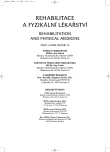Recognize of Motor Disorders in First Year Life - Sensitivity and Specificity of Position Reactions
Authors:
M. Kofránková; A. Doležal
Authors‘ workplace:
Klinika RFM ILF, Praha
; Ústav histologie a embryologie 3. LF UK, Praha
Published in:
Rehabil. fyz. Lék., 15, 2008, No. 1, pp. 18-21.
Category:
Original Papers
Overview
I have evaluated the sensitivity and specificity of the tests of posture reactions which are used in diagnostics of developmental motor disorders in infants and in indications to Vojta therapy (1, 2). For this I have used the documentation of the children examined at the department of physiotherapy at Teaching Hospital Royal Vineyard (FNKV). The examination concerned the sample of 100 healthy children and 100 children with developmental motor disorders from that documentation from years 1977–2006.
The highest sensitivity showed the test of Vojta lateral tilt:
81%. Test of horizontal line of Collis showed sensitivity of 74%, test of vertical line of Collis showed 68%, Peiper-Isbert’s test showed 51%, traction test showed 48%, armpit’s hanging position test showed 31% and Landau’s test showed 21%.
The highest specificity showed the traction test (93%) and the Peiper-Isbert’s test (93%), then the Landau’s test and the armpit’s hanging position test showed specificity of 91%, the test of Vojta lateral tilt showed 89%, the test of horizontal line of Collis showed 89% and the test of vertical line of Collis showed 88%.
On account of evidenced high specificity and sensitivity of the tests of posture reactions and high efficiency of Vojta therapy and being aware of the fact that the efficiency is the higher the earlier the therapy is started, we propose to consider as suggestion that the pediatricion should learn to use besides the traditional examinated traction test of Prechtl also the two most sensitive tests (Vojta lateral tilt and test of horizontal line of Collis). In this case he would be able to recognize the child in danger earlier and more distinctly and the child could be send to the specialized departement in time.
Key words:
sensitivity and specificity of position reaction, locomotor disorders in children, Vojta metod, reflex locomotion
Sources
1. VOJTA, V.: Mozkové hybné poruchy v kojeneckém věku. Praha, Grada (Avicenum), 1993.
2. VOJTA, V., PETERS, A.: Vojtův princip. Praha, Grada (Avicenum), 1995.
3. IMAMURA, S., SAKUMA, K., TAKAHASHI, T.: Follow up study of children with cerebral coordination disturbance (CCD, Vojta), Brain dev., 5, 1983, 3, pp. 311-314.
4. KOLÁŘ, .ZOUNKOVÁ: Lékařské listy, 49, 2000, s. 26.
Labels
Physiotherapist, university degree Rehabilitation Sports medicineArticle was published in
Rehabilitation & Physical Medicine

2008 Issue 1
Most read in this issue
- Viscoelastic Properties of Fibrous Connective Tissue and Manual Treatment
- Vibration: Neurophysiological Aspects and Possibilities of Clinical Application
- Active Life Style and its Changes in Patients with Chronic Low-Back Pain
- Recognize of Motor Disorders in First Year Life - Sensitivity and Specificity of Position Reactions
